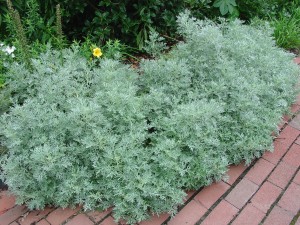Most artemisias (aka “wormwood”) can not cope with the summer heat and humidity in the mid-South. Their silvery foliage tends to burn out (some say “melt out”) in mid to late summer. ‘Powis Castle’ artemisia is truly the exception. Powis Castle is likely a hybrid (Artemisia arborescens x A. absinthium
Powis Castle is a bushy, woody-based perennial or subshrub which forms a 2-3 foot high and wide mound. Powis Castle rarely flowers. Its finely divided foliage is evergreen in most gardens in the Southern Appalachian region (USDA hardiness zones 6 and 7). The silvery foliage creates an excellent contrast with green and other colorful leafy plants in the garden.
Artemisias are best planted in well drained soil and in full sun. They tend to grow poorly in soggy winter soils. No soil fertilizing is generally necessary. Diseases and insect problems are of little consequence.
Older plants tend to run randomly because of their rhizomatous root system. Do not cutback artemisias in the fall. Instead, treat them as hardy mums or asters and wait until new spring growth appears before pruning back. Tidy up the garden bed to recapture a fresh new foliage look.
Its aromatic foliage is cut and utilized in creating fresh herbal wreaths and in potpourri. During medieval times wormwood was a popular remedy for whatever ailed you from gout, kidney stones, scurvy and liver problems.


 Posted in
Posted in 
